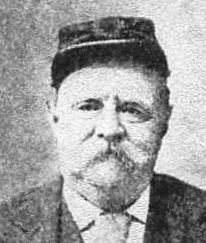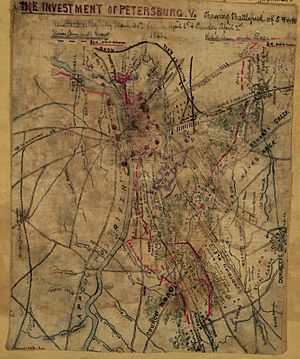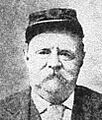William Sands (soldier) facts for kids
Quick facts for kids
William Sands
|
|
|---|---|

William Sands, c. 1903
|
|
| Born | October 14, 1835 Reading, Pennsylvania |
| Died | October 31, 1918 (aged 83) Norristown, Pennsylvania |
| Buried |
Charles Evans Cemetery, Reading, Pennsylvania
|
| Allegiance | |
| Service/ |
U.S. Army (Union Army) |
| Years of service | April 23—July 29, 1861; September 12, 1861—May 31, 1865 |
| Unit | |
| Battles/wars | American Civil War:
|
| Awards | |
William Sands (born October 14, 1835 – died October 31, 1918) was a brave soldier from the United States. He fought for the Union Army during the American Civil War. Sands served as a musician and later as a first sergeant in the 88th Pennsylvania Infantry regiment.
He earned the highest award for bravery in the U.S., the Medal of Honor, for an amazing act. During the Battle of Hatcher's Run in Virginia in February 1865, he captured an enemy flag. He carried this flag from behind the enemy lines all the way back to his own Union Army side. He received this special award on November 9, 1893.
Contents
Early Life
William Sands was born in Reading, Pennsylvania, on October 14, 1835. His mother was Harriet Sands. He grew up and went to school in Reading.
In the late 1850s, he got married to Hetty. By 1860, they lived in Reading with their baby son, George.
Serving in the Civil War
The American Civil War began in April 1861. William Sands joined the army just ten days after the attack on Fort Sumter. He signed up in Reading, Pennsylvania, on April 23, 1861. He became a private in Company G of the 7th Pennsylvania Infantry.
His regiment moved to different camps, including Chambersburg, Pennsylvania and Williamsport, Maryland. They then marched to Martinsburg, West Virginia. After three months of service, Sands and his regiment were honorably discharged on July 29, 1861.
Rejoining the Fight
Sands quickly decided to serve again. On September 12, 1861, he re-enlisted in Philadelphia. He joined the 88th Pennsylvania Infantry for three years. He was a field musician in Company B.
At this time, Sands was 25 years old and worked as a painter. He was about 5 feet, 6 inches tall, with sandy hair and brown eyes.
In October 1861, Sands and his regiment went to Washington, D.C.. They helped protect the nation's capital. Later, they were sent to Alexandria, Virginia, for guard duty.
Major Battles
The 88th Pennsylvania Volunteers faced their first big battle at Battle of Cedar Mountain on August 9, 1862. They fought bravely there. After this, they moved to other areas, including Manassas.
They were praised by General John Pope for their actions in the Second Battle of Bull Run. This battle took place on August 29–30.
Next, they fought in the very tough Battle of Antietam on September 17. After more fighting, they camped for the winter. In January 1863, they took part in Major-General Ambrose Burnside's Mud March. This operation did not go well.
They returned to their winter camp. Later, they fought along the Rappahannock River. They then joined the Gettysburg Campaign.
Captured at Gettysburg
On July 1, 1863, the first day of the Battle of Gettysburg, William Sands was captured by Confederate soldiers.
After being captured, Sands was later released in a prisoner exchange. He returned to his unit and recovered. In February 1864, he re-enlisted again. He was promoted to principal musician and joined the regiment's main command.
The Overland Campaign
In May 1864, Sands and his regiment joined Lieutenant-General Ulysses S. Grant's Overland Campaign. They fought in several battles:
- Battle of Spotsylvania Court House (May 8 and 12)
- Battle of North Anna (May 23)
- Battle of Totopotomoy Creek (May 26)
After these battles, they joined the Siege of Petersburg. During this long siege, Sands and his regiment bravely attacked enemy positions. They faced heavy artillery fire and sharpshooters.
Medal of Honor Action
On January 31, 1865, Sands was promoted again to first sergeant. He was transferred to Company G's command staff.
In February, his regiment was sent to the Battle of Hatcher's Run (also known as Dabney's Mill). This battle took place on February 6–7, 1865. It was here that William Sands performed the act that earned him the Medal of Honor. He captured an enemy flag and brought it back to the Union lines.
Captain Aaron Bright, Jr., who was leading the 88th Pennsylvania, wrote a report about the battle. He said that First Sergeant William Sands and another soldier "displayed bravery unequaled." This shows how incredibly brave Sands was during this difficult fight.
Final Campaigns and Injury
After the battle, the regiment rested. In March 1865, they joined the Appomattox Campaign. They fought in the battles of Battle of Five Forks (April 1) and Battle of Amelia Springs (April 5).
During the Battle of Amelia Springs, just four days before the Confederate Army surrendered, Sands was shot in his right thigh. He was treated at a hospital and later honorably discharged from the army on May 31, 1865, due to his injury.
Life After the War
After leaving the military, William Sands went back home to his wife in Berks County, Pennsylvania. He started working as a painter again. By 1870, he lived in Reading with his wife and mother.
Later in life, around 1911, Sands moved to Norristown, Pennsylvania. He worked there as an attendant at the Norristown State Hospital.
William Sands passed away in Norristown on October 31, 1918. His body was brought back to Reading and buried in the Charles Evans Cemetery.
Images for kids



